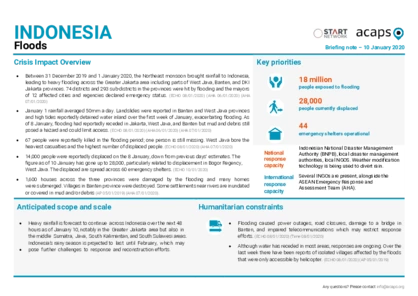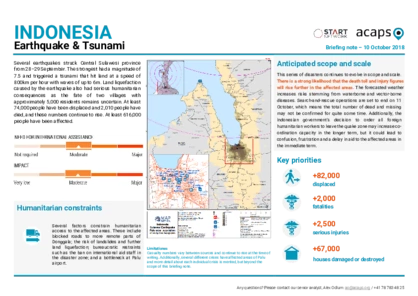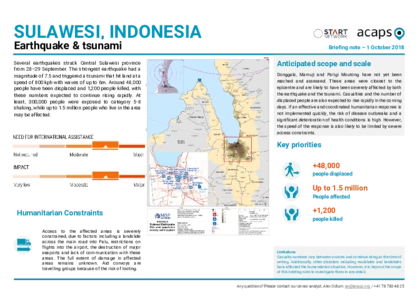Latest updates on country situation
02 December 2025
Large parts of western Indonesia, particularly across the Sumatra region, have been overwhelmed by torrential monsoon rains and a rare tropical storm, resulting in catastrophic floods and landslides. The death toll has risen to 708, with 504 people still missing and more than 3.2 million people affected. Provinces including Aceh, North Sumatra, and West Sumatra are experiencing severe devastation. Roads, bridges, and power infrastructure have been destroyed, cutting off access to many communities. One million people have been evacuated from Sumatra according to media. Many remain stranded as rescue teams deploy boats, helicopters, and naval vessels to reach isolated areas. Homes, farmland, and entire villages have been submerged or swept away, while widespread damage to power and communication networks continues to hinder relief operations. Affected populations urgently require emergency shelter, food, clean water, healthcare, WASH support, and repairs to critical infrastructure as humanitarian needs escalate. (Reuters 03/12/2025, IFRC 01/12/2025, The Guardian 02/12/2025)
03 July 2025
New waves of displacement were reported in June due to ongoing armed conflict between Indonesian security forces and the West Papua National Liberation Army (TPNPB). Displacement increased significantly from 86,886 to 97,650 IDPs over March-June. Entire districts such as Sinak in Puncak and Hitadipa in Intan Jaya have become completely depopulated, as residents fled to escape intensified clashes. Conflict has damaged schools, health centers, and roads, especially in Nduga, Intan Jaya, and Maybrat. Many public facilities remain non-functional or abandoned, limiting access to education, healthcare, and mobility for displaced and conflict-affected communities.
According to local sources, many of the displaced are reportedly sheltering in severely overcrowded conditions. In Nabire, up to seven families were found sharing a single dwelling. Food shortages mean most IDPs are surviving on just one to two meals per day, while many have lost their homes and livestock. Access to healthcare and education is critically limited, especially for children.
24 September 2024
Until 19 September 2024, West Papua territory (Western New Guinea) hosted an estimated 80,000 IDPs. These displacements were a result of low-intensity armed conflict between Indonesian forces and the West Papua National Liberation Army (TPNBP), especially since 2018. The conflict has continued throughout 2024, with new IDPs recorded between June—August in Maybrat and Puncak regencies. IDPs returning to their villages report a significant presence of Indonesian forces and express concerns about a possible increase in conflict with the TPNBP. The IDPs in West Papua territory urgently need food, healthcare, education, livelihoods, and protection. Many of them have been living in the forests for years and sleeping in the open or under tents. Military personnel are reported to be continuing their occupation of many offices, healthcare and education facilities, and homes. Humanitarian access to the affected people is very limited, mainly with the restrictions imposed by the Indonesian Government. (HRM 19/09/2024, ACLED accessed 24/09/2024, The Diplomat 26/04/2024)
09 April 2024
Since 2018, there has been an increasing number of security incidents and related fatalities, peaking in 2023, in West Papua territory. The region comprises the six Papua provinces of Indonesia. Violence and armed conflict, mostly related to fighting between the Indonesian military and the armed group West Papua National Liberation Army, have caused displacement. As at October 2023, there were an estimated 76,000 IDPs in the region. Many IDPs are reluctant to return to their homes given the presence of Indonesian security forces. These IDPs need food, adequate shelter, healthcare support, protection, education, and WASH services. Many IDPs have sought refuge in forests, where access to basic services is very limited. Many public facilities, such as schools, health facilities, and churches, have been turned into military infrastructure, limiting Papuans' access to basic services. Humanitarian access to the region is very restricted. (HRM 06/10/2023, HRM 18/01/2024, The Diplomat 06/04/2024)
05 September 2023
A combination of hailstorms, frost, and drought, attributable to the global El Niño phenomenon, has destroyed crops and caused food shortages in Indonesia’s Central Papua province, affecting Puncak Regency the most. Around 8,000 people urgently need food assistance. Other needs include blankets, cold weather clothes, and medicine. (STC 05/09/2023, FAO/OCHA 31/08/2023)
current crises
in
Indonesia
These crises have been identified through the INFORM Severity Index, a tool for measuring and comparing the severity of humanitarian crises globally.
IDN002 - Conflict in Papua
Last updated 28/11/2025
Drivers
Conflict/ Violence
Crisis level
Country
Severity level
2.6 Medium
Access constraints
4.0
Analysis products
on
Indonesia
15 October 2024
Indonesia: Humanitarian impacts of continuing conflict in the Papua provinces
DOCUMENT / PDF / 294 KB
This report highlights developments in the conflict in Papua in 2024, which indicate worsening humanitarian needs among affected communities. The report emphasises significant humanitarian access constraints and response gaps and examines the outlook in the coming months.
Attached resources
25 November 2022
Indonesia: Earthquake in West Java province
DOCUMENT / PDF / 319 KB
On 21 November 2022, an earthquake measuring 5.6 on the Ritcher scale occurred at a depth of 10km in the West Java province of Indonesia. The earthquake has damaged at least 56,300 houses and has displaced around 61,000 people. At least 58,000 people are living in shelters.
10 January 2020
Indonesia: Floods
DOCUMENT / PDF / 465 KB
Between 31 December 2019 and 1 January 2020, the Northeast monsoon brought rainfall to Indonesia leading to heavy flooding across the Greater Jakarta area.14,000 people were reportedly displaced on the 8 January, down from previous days' estimates. The displaced are spread across 60 emergency shelters.
10 October 2018
Indonesia: Earthquake and Tsunami Update
DOCUMENT / PDF / 1 MB
Several earthquakes struck Central Sulawesi province from 28–29 September. Land liquefaction caused by the earthquake also had serious humanitarian consequences as the fate of two villages with approximately 5,000 residents remains uncertain. At least 74,000 people have been displaced and 2,010 people have died, and these numbers continue to rise. At least 616,000 people have been affected.
01 October 2018
Indonesia: Earthquake and Tsunami
DOCUMENT / PDF / 1 MB
Several earthquakes struck Central Sulawesi province from 28–29 September. The strongest earthquake had a magnitude of 7.5 and triggered a tsunami that hit land at a speed of 800 kph with waves of up to 6m. Around 42,000 people have been displaced and 1,200 people killed, with these numbers expected to continue rising rapidly. At least, 300,000 people were exposed to category 5-8 shaking, while up to 1.5 million people who live in the area may be affected.






